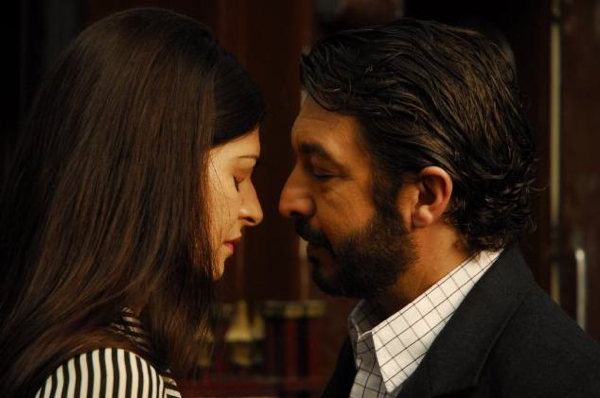Movie review by Greg Carlson
Filmmaker Juan Jose Campanella, who works regularly in both Argentina and the United States, crafts an engrossing blend of detective procedural, legal thriller, and romance in “The Secret in Their Eyes,” winner of the 2009 Best Foreign Language Film Academy Award. The movie is based on Eduardo Sacheri’s (slightly) differently titled novel “The Question in Their Eyes,” and author and director collaborated on the screenplay. The adaptation embraces melodramatic flourishes even as it makes room for serious questions about the nature of justice and punishment. Jumping back and forth between 1974 and 2000, “The Secret in Their Eyes” uses its dual chronology to explore themes of longing and regret, as well as class differences and the political corruption of the right-wing elements of Peronism.
Told mostly in flashback, “The Secret in Their Eyes” begins with former court investigator Benjamin Esposito (Ricardo Darin) constructing a passage for a novel inspired by a memory that has haunted him for a quarter of a century. A young woman named Liliana Colotto is savagely raped and beaten to death in her Buenos Aires home. Esposito promises Colotto’s widower (Pablo Rago), a gracious, sensitive – and now devastated – bank employee, that he will find the murderer. Against the better judgment of Esposito’s supervisor Irene (Soledad Villamil), for whom the man carries a white-hot torch, permission is reluctantly granted to continue work on the case even after it has been frustratingly and unfairly closed.
Like Laura Hunt and Laura Palmer, the spectral presence of Liliana casts a spell on the film’s protagonist and its viewers, and Campanella exploits the ways in which expectations of coded masculinity inform and direct Esposito’s motivations and choices, especially in terms of how his forbidden love for Irene fuels his desire to track Colotto’s assailant. Despite Irene’s affection for her co-worker, she is both engaged to be married to someone else and is Esposito’s superior. Additionally, the social gulf that separates Irene and Esposito prevents him from acting on his feelings. As a result, he focuses on the crime against Liliana, because it affords him a small measure of control.
Campanella, whose American directing credits include episodes of “House M.D.,” “Law & Order: Special Victims Unit,” “30 Rock,” and “Strangers with Candy,” draws on his experiences with drama and comedy, infusing “The Secret in Their Eyes” with a sense of wry, deadpan humor that tempers the grim details of the central offense. Esposito’s partner Sandoval (Guillermo Francella), a sloppy alcoholic with a knack for pulling clues together, provides comic relief and an unflagging commitment to his friend. Sandoval takes center stage during a spectacularly staged foot-chase shot as a sweeping long take at a packed football stadium. Later, the character anchors one of the movie’s most tragic encounters, a symbol of Argentineans swallowed up by a regressive political regime.
Sandoval is one of a half-dozen memorable figures in the story, and the plot’s twists and surprises, which continue to the end of the film, should ignite discussion about the scope and scale of restitution, retribution and redress, particularly in the manner of how a penalty is meted out. Cicero’s classic equation of proportionality between crime and punishment does not answer whether an eye for an eye provides an adequate measure of correction, and “The Secret in Their Eyes” just as easily calls to mind Voltaire’s note that “The punishment of criminals should serve a purpose. When a man is hanged he is useless.”
